The fossil record refers to the collection of preserved remains, traces, and imprints of past life forms found within Earth’s geological layers. Young-earth paleontologists use this invaluable tool to understand earth history. Specifically, history leading up to the Flood, the Flood itself, and its aftermath. It is most intriguing then, that humans do not show up until the very top of the fossil record. The top contains the most recent traces of ancient life.
On its surface, this seems problematic since the Genesis account places humanity’s origins at the very beginning. Matthew 19:4 backs this up. Jesus says to His audience, “Have you not read that He who created them from the beginning made them male and female?” Jesus’ response regards a question about divorce and marriage. However, it is based on the premise that our original parents, Adam and Eve, were created in the beginning of time. Yet, when we turn to the geologic record, the oldest human remains are absent until the most recent rock layers. How can we explain this discrepancy?
The views expressed in this article reflect those of the author and not necessarily those of the New Creation blog.
Order of the Fossils
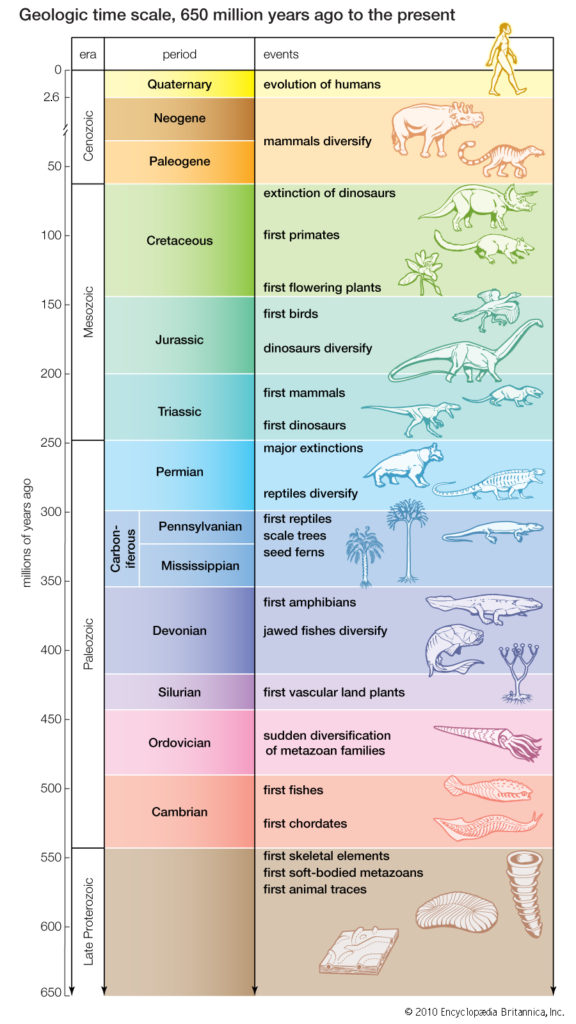
The order in which fossils show up in the earth’s rock layers is not random. They tend to occur in a predictable order anywhere you go in the world. We can correlate rock outcrops across the earth’s surface and document which fossils occur in which layers. In this way, we can understand their general sequence. We can segregate the fossil-bearing rock record into four main sections. It begins with the oldest on the bottom and moves up to the youngest at the top. We see, in that order, the Precambrian, the Paleozoic, the Mesozoic, and the Cenozoic.
The majority of the Precambrian fossil record consists of single-celled organisms, like algae and microbes. Above these, the Ediacaran (uppermost Precambrian) and Paleozoic rocks contain a plethora of complex lifeforms. They are primarily dominated by shallow marine organisms, such as trilobites, brachiopods, and an assortment of fish. Within Paleozoic rocks, we find plants, insects, and extinct varieties of amphibians and reptiles.1 However, most of these could have come from giant floating forest ecosystems that floated across the ocean.2 As such, they are not from truly terrestrial environments. The Mesozoic is where we begin finding fossils of archosaurs (crocodilians, dinosaurs, and pterosaurs). Here, most modern groups of flowering plants, reptiles, and amphibians also appear. Mammals show up in the Mesozoic layers as well, but these are mostly small and unlike those alive today. Most modern groups of mammals and birds do not appear in the fossil record until the Cenozoic.
Throughout the vast majority of the fossil-bearing layers, human fossils and artifacts are absent. They only appear in the most recent portion of the fossil record. Why is that? From an old-earth perspective, this is easy to explain. They would say humans did not appear until relatively recently, almost 3 million years ago. But from a young-earth creationist perspective, humans have been around since the very beginning, minus five days.
The Fossil Record of Humanity
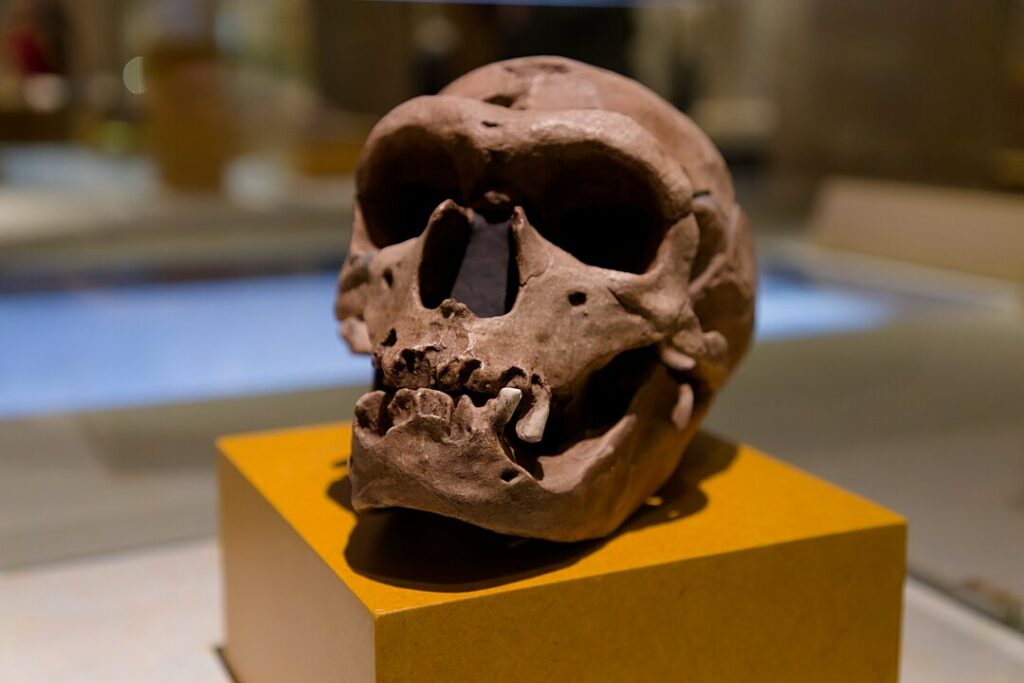
Most people use the word “human” to refer exclusively to our own species, Homo sapiens. But when we consider our fossil record, we discover that ancient humans came in far more shapes and sizes than we do today. Many, such as Neanderthals, have been assigned to different species. The Bible is clear about the origin of our humanity. God uniquely formed us in His own image, with us being Adam, Eve, and all of their descendants. As such, we can understand “human” to simply mean a descendant of Adam and Eve. This applies whether they have been dubbed as Homo sapiens, Homo erectus or some other name. Creationist studies looking at the physical traits of humans and traces of ancient culture suggest that humanity roughly corresponds with the genus Homo in scientific taxonomy.
The earliest members of our genus do not appear in the fossil record until almost the very top. They are found in a high layer of the Cenozoic, called the upper Neogene. On the conventional timescale, they date to approximately 2.8 to 2.4 million years old. There is good reason to reject this estimate as an absolute date. It can, however, help us place human fossils in a time frame relative to other fossils in the fossil record.
When Do Humans Show Up in the Fossil Record?
The Dmanisi skulls, from the Republic of Georgia, are the earliest Homo fossils known outside of Africa.3 They date to 1.9 million years old on the conventional timescale. The oldest known stone tools outside of Africa were found in Shangchen, China and date to 2.1 million years old.4 Other fossil remains discovered in Koobi Fora, in Africa, date to 1.88 million years.5 There are also some Homo fossils in Java that date to 1.81 million years.6 According to a conventional timescale, these dates differ by at least 200,000 years. They are, however, nearly concurrent with each other if rescaled to a young-earth timescale. This suggests that humans radiated out from a central point relatively early on in their history.
How do we reconcile the absence of human remains throughout most of the fossil record with the biblical fact that we have existed since almost the very beginning of earth history?
Absence of Human Evidence is Not Evidence of Human Absence
To answer this question, we must peruse through the major divisions of the fossil record. Here, we will examine the factors that might lead to their absence. Of note, several young-earth models of our planet’s history exist. But for the sake of simplicity, we will primarily be looking at the one most widely-accepted by creation scientists.
Most of the Precambrian: Days 1-3 of Creation Week
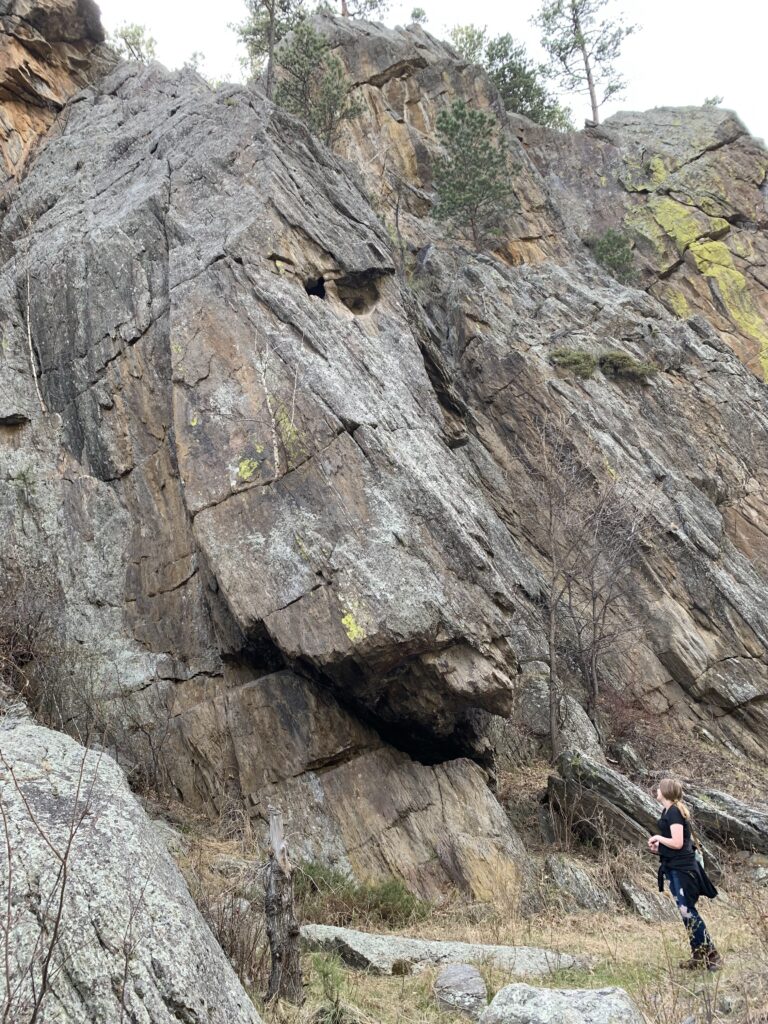
Fossils of complex lifeforms, including humans, are absent from the vast majority of the fossil record. Most young-earth geologists agree that the Precambrian largely represents “basement rocks,” which they believe God created prior to Day 4 of Creation Week.7 He created plants on Day 3 after dry land formed. He did not bring animals into existence until Days 5 and 6. Therefore, we should not expect to find humans in the majority of Precambrian rocks because we believe God created these units before humans even existed!
Ediacaran & Paleozoic: Early Flood

After the events of Day 3, most young-earth geologists do not think much geologic activity occurred until the beginning of the Flood.8 This means there was little opportunity for burial and fossil preservation. As such, the fossilization of humans or other animals could not occur until the beginning of the Flood.
Most young-earth paleontologists believe that the earliest casualties of the Flood are marine life forms. These lived on the edges of the pre-Flood continent(s) and/or were swept off the floors of shallow continental oceans. They were preserved in Ediacaran and the majority of Paleozoic rocks. It is thought that, as this was occurring under water, the floating forest that drifted atop the ocean was also being destroyed, its components buried atop earlier Paleozoic sea creatures. These deposits reflect marine ecological communities. It therefore makes little sense for humans and their remains to be associated with them. The Flood was not yet devastating land-based environments.9
Mesozoic: Mid- to Late-Flood
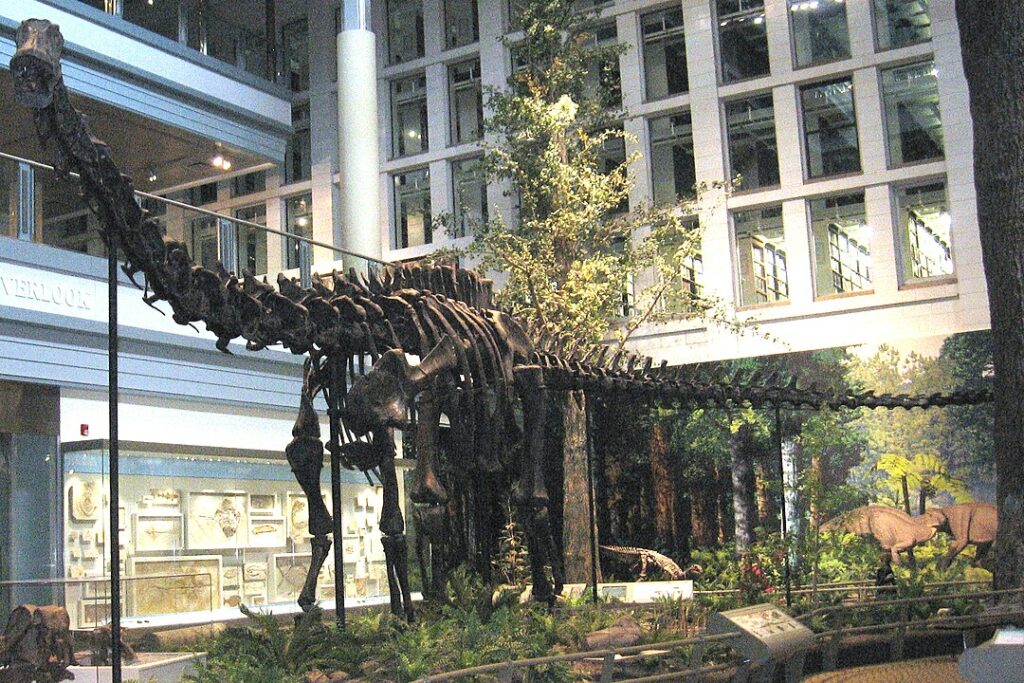
The Flood did not instantly inundate the whole world at once. The Flood narrative in Scripture seems to suggest that it did so over a period of weeks or months. During this point, researchers think the rising floodwaters picked up and transported land animals and plants (including dinosaurs). The waters then buried them in Mesozoic sediments above Paleozoic layers.
From the fossilized remains of these ecosystems, it seems they would not have been conducive to complex human societies. The plants dominating most of these habitats are non-flowering plants, like ferns, cycads, and conifers. Nearly all the foods humans consume, however, are either flowering plants (angiosperms) or animals that eat flowering plants. Researchers have found flowering plants alongside dinosaurs, but they are a relatively minor component of those ecosystems. The seeds of these plants also tend to be quite small.10,11
Raising livestock to eat would also prove difficult in a dinosaur-friendly habitat, as they too are reliant on flowering plants. Fossil evidence of grasses (which include wheat, maize, and rice) do show up in these layers. They are rare, however, and have limited distribution, which means that the grasslands required for grazing livestock are absent.12
These factors suggest it may have simply been safer and more efficient for humans to live in regions where the dinosaurs were not. This begs a question: why don’t humans show up in the Flood’s fossil record at all? After all, they still had to live somewhere, later to perish during the same event. We will explore some possible explanations of this later.
Cenozoic: Post-Flood
Late Dispersal

Residual natural disasters followed after the Flood for decades to millennia. Such events still provided ample opportunity to bury organisms and preserve them as fossils. However, one major factor against human fossilization through most of the post-Flood period may have to do with their late dispersion.
God commanded all animals to fill the earth after the Flood (Genesis 8:17). Humans instead chose to disobey Him and congregated in a plain located in the land of Shinar (Genesis 11:2). There, they built a city with a tall tower, “ensuring” that they would not be scattered across the earth (Genesis 11:4). Despite their self-confidence, God caused them to scatter anyway. In addition, He confused their languages so that they could not understand each other (Genesis 11:7-8).
The timing of the Tower of Babel is up for debate. However, many creation scientists correlate it with the division of the earth recorded to have occurred in the days of Peleg.13 During the time before the dispersion, animals spread throughout the world. Many of them are preserved in the fossil record of the Cenozoic. We can tentatively correlate the abrupt, wide distribution of genus Homo throughout the Old World to the dispersion from Babel.
Long Lifespans
Another possible factor is the longevity of human lifespans. Before the Flood, Noah’s ancestors regularly lived into their 900s (Genesis 5). Noah’s lineage leading up to Abraham continued to live hundreds of years at a time, but they successively declined until their 100s, as was the case with Abraham (Genesis 11). If people lived for so long, infant mortality, disease, predation, and similar causes of death would be the exception. If humans were generally not dying, they would leave no fossils behind until much later in history. It should be noted, however, that this assumes that the lifespans of Noah’s/Abraham’s lineage was representative of all other humans alive at the time, which is something Scripture does not explicitly state.
What Happened To Humans During the Flood?
Creation scientists have developed a comprehensive model of young-earth history that may explain why humans and their remains do not appear throughout large portions of the fossil record. Questions still remain, however. Perhaps one of the most burdensome is why they do not appear in the Flood’s portion of the fossil record at all!
Taking the model described above into consideration, creation scientists proposed several possible explanations for why their absence could be the case. This is still an active area of creation research ripe for investigation. Bear in mind that the hypotheses described below are not mutually exclusive. Some or all of them may have been factors in humanity’s absence from the Flood rock layers.
Fleeing the Flood?
One idea offered by several creation scientists is that humans may have escaped the Flood’s initial destructive phases, only to be destroyed later on.14 After all, as stated previously, it appears that the early floodwaters wiped out many sea-dwelling lifeforms. Land-dwelling plants and animals did not succumb to the Flood until some time later, when their ecological communities were swept away, transported, and buried.
There is a difficulty with this explanation, however. Are we to expect that every human made a mad dash to the absolute highest pre-Flood regions so that they could be spared until the very latest stages of flooding, all while avoiding being swept away, buried and fossilized? It is unlikely that all humans would be able to migrate over vast distances during a massive Flood. More likely, any humans fleeing from the Flood would only succeed in escaping to a local topographic high point. And what of the missing evidence for pre-Flood civilizations? Buildings and human artifacts have no such ability to flee, so this explanation cannot account for their absence. Mobility is probably an insignificant factor here.
Small, Isolated Population Size?
Another hypothesis has to do with the population size and distribution of humans before the Flood.15 We do not know how many people were on the earth when the Flood happened, or where they were living. Generally speaking, though, the lifeforms that tend to contribute the most to the fossil record are those that are widespread and very numerous. Smaller organisms with tough shells, like the various species of mollusks, fulfill both of these criteria. We find their shells not only throughout the fossil record, but also accumulated along beach shores today.
Compare this with the fossil record of coelacanths. Researchers thought this group of fish was extinct due to their fossil record ending at approximately the same place as the dinosaurs. But to everyone’s surprise, in the 1930s, researchers discovered not one, but two populations of living coelacanths. The reason coelacanths did not contribute to the Cenozoic fossil record is because they are relatively few in number and only live in certain, hard-to-access regions of the world. Even if they did leave fossils behind, it is unlikely that we would ever find them because they would be at the bottom of the ocean. Perhaps something similar happened with pre-Flood humans and their remains.
Were Humans Living Somewhere Unique in the Pre-Flood World?
The fact that four rivers flowed out of Eden implies that it was located at a higher elevation. Eden is where God placed the original humans. Regions of higher elevation like Eden tend to experience significant erosion. They are therefore not favorable toward the preservation of fossils, which requires burial. Based on this, geologist Dr. Ken Coulson has suggested that Eden was also restricted to a single, although large, geographic region.16 Granting that some people moved away from Eden, it is not a stretch to suggest that the majority of pre-Flood people were still located in that general vicinity by the time of the Flood.
Similarly, geologist Dr. Tim Clarey has suggested that pre-Flood humans may have lived in pre-Flood upland regions.17 He proposes that the Flood significantly affected regions of lower elevation first. Flooding over continents thousands of miles away was therefore not likely a threat to pre-Flood humans at this point.
Completely Destroyed?
In fact, this problem is not unique to humans specifically. Researchers only find fossils representing most modern groups of mammals, birds, and flowering plants in the Cenozoic. These same fossils are almost absent from Flood-formed rock layers. This suggests that an entire ecological community of these humans and other lifeforms were not preserved in the fossil record. This is easier to explain during the global Flood than trying to explain why a single, specific lifeform is missing from the Flood rocks.
As a result, some young-earth geologists have proposed another idea. During the worldwide Flood of Noah’s time, they suggest land-dependent organisms not buried or decomposed instead faced destruction by abrasion.18,19 They argue that the submarine mass flows may have induced immense abrasive power. So much so that they abraded the bones and flesh of many humans and other animals into solutions. In addition, they suggest that the waters expelled from the “fountains of the great deep” were acidic. As such, they could have assisted the abrasion process of any humans or animals caught in their torrents. We should note that this explanation is very dependent on certain Flood models.
Where Does This Leave Us?
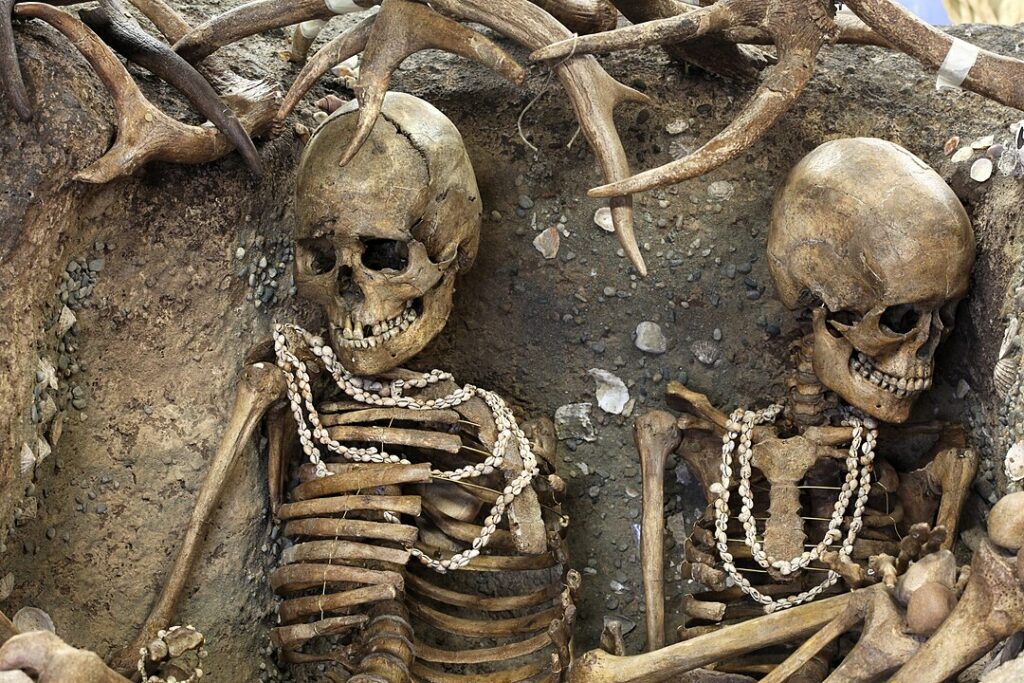
At this time, we cannot confidently say why humans and their artifacts only show up toward the uppermost portions of the fossil record. This gap in our knowledge should not dishearten us. After all, our model of young-earth history as it currently exists is readily able to explain the absence of human remains throughout most of the fossil record. We have come a long way since the likes of George McCready Price, who thought there was no consistently-ordered fossil record to begin with. We have developed powerful models for explaining various portions of the fossil record, even better than our old-earth colleagues! With the Lord’s blessing, what other mysteries can we solve as we continue to explore the amazing history of the world He created?
Footnotes
- The term amphibian can be used to mean either just the living amphibians (Lissamphibia) or all of the four-legged animals that aren’t amniotes (birds, reptiles, and mammals). ↩︎
- Sanders, R.W., and S.A. Austin. (2018). “Paleobotany supports the floating mat model for the origin of Carboniferous coal beds.” In Proceedings of the Eighth International Conference on Creationism, ed. J.H. Whitmore, pp. 525–552. Pittsburgh, Pennsylvania: Creation Science Fellowship. ↩︎
- Garcia, T., Féraud, G., Falguères, C., de Lumley, H., Perrenoud, C., & Lordkipanidze, D. (2010). “Earliest human remains in Eurasia: new 40Ar/39Ar dating of the Dmanisi hominid-bearing levels, Georgia.” Quaternary Geochronology, 5(4), 443-451. ↩︎
- Zhu, Z., Dennell, R., Huang, W., Wu, Y., Qiu, S., Yang, S., Rao, Z., Hou, Y., Xie, J., Han, J. and Ouyang, T. (2018). “Hominin occupation of the Chinese Loess Plateau since about 2.1 million years ago.” Nature, 559(7715), 608-612. ↩︎
- McDougall, I. 1985. “K-Ar and 40Ar/39Ar dating of the hominid bearing Pliocene-Pleistocene sequence at Koobi Fora, Lake Turkana, northern Kenya.” Geological Society of America Bulletin 96:159-175. ↩︎
- Swisher, C.C., G.H. Curtis, T. Jacob, A.G. Getty, A. Suprijo, and Widiasmoro. 1994. “Age of the earliest known hominids in Java, Indonesia.” Science 263:1118-1121. ↩︎
- Dickens, H. and Snelling, A.A. 2008. “Precambrian geology and the Bible: a harmony.” Journal of Creation 22(1):65–72. ↩︎
- While most young-earth geologists think that minimal geologic activity occurred before the Flood, some have suggested that geologic activity occurred after the Fall and successively increased, culminating in the Flood itself. ↩︎
- Technically, the first land-derived deposits we find from the Flood likely occur in Permian strata, which is at the very top of the Paleozoic. These likely reflect the destruction and subsequent burial of pre-Flood coastal communities of plants and animals. ↩︎
- Barnosky, A. D. 2008. “Megafauna biomass tradeoff as a driver of Quaternary and future extinctions.” Proceedings of the National Academy of Sciences, 105(supplement_1), 11543-11548. ↩︎
- Manchester, S. R., Grímsson, F., & Zetter, R. 2015. “Assessing the fossil record of asterids in the context of our current phylogenetic framework.” Annals of the Missouri Botanical Garden. Missouri Botanical Garden, 100(4), 329. ↩︎
- Strömberg, C. A. 2011. “Evolution of grasses and grassland ecosystems.” Annual review of Earth and planetary sciences, 39, 517-544. ↩︎
- Sibley, A. 2017. “Dating the Tower of Babel events with reference to Peleg and Joktan.” Journal of Creation, 31(1), 80-87. ↩︎
- Snelling, A.A. 1991. “Where are all the human fossils?” Creation 14(1):28-33. ↩︎
- Purifoy, T. (Director). 2017. Beyond Is Genesis History, Vol 1: Rocks and Fossils. Compass Cinema. ↩︎
- Coulson, K.P. 2018. “Global deposits of in situ upper Cambrian microbialites—Implications for a cohesive model of origins.” In Proceedings of the Eighth International Conference on Creationism, ed. J.H. Whitmore, pp. 373–388. Pittsburgh, Pennsylvania: Creation Science Fellowship. ↩︎
- Clarey, T.L., and D.J. Werner. 2018. “Use of sedimentary megasequences to re-create pre-Flood geography.” In Proceedings of the Eighth International Conference on Creationism, ed. J.H. Whitmore, pp. 351–372. Pittsburgh, Pennsylvania: Creation Science Fellowship. ↩︎
- Dickens, H., Snelling, A. 2015. “Terrestrial Vertebrates Dissolved Near Fountains.” Answers Research Journal Vol 8: 437-447. ↩︎
- Dickens, H. and Hutchison, A. 2021. “Geochemical and related evidence for early Noah’s Flood year.” Journal of Creation 35(1):78-88. ↩︎


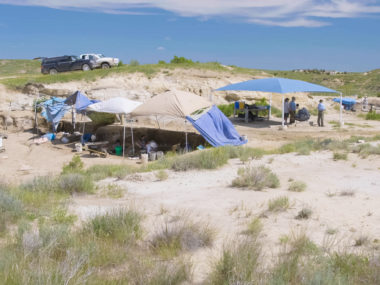




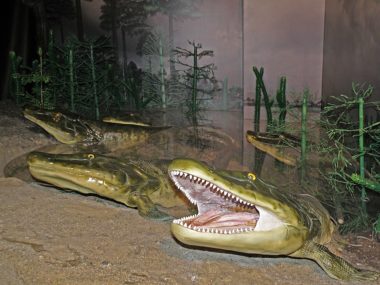




The enormously powerful erosion and abrasion of hard crystalline rocks evident from the Great Unconformity would be enough to blot out (Gen 6 & 7) land animals and people in the early Flood.
This comment is about 3 things. 1 -humans was first spiritual beings in Gn 1:27. there is a spiritual creation and a physical creation. Hebrews 11:3
2- while the spiritual creation have no beginning or ending it have dispensations that took place.
while the spiritual world was moving from dispensations to dispensation, like Eions, god and goddess, eternity past, sons of God, Genesis 1:1 and Proverbs 8:22-36, the physical side had to pass through a prehistoric sets of dispensation as well dinosaurs, giants, angelic wars, then ancient humans, then Genesis 1:2. where the Sun and Moon and stars came into existence,
God is a Spirit John 4:24 so the spiritual creation will never change only the physical creation will end 2 Peter 3:7
The work of the Cross and Redemption is making people spiritual so that they can be complete body, soul and spirit, 1TH5:23 to see God and be called children of God we have a fallen spiritual nature, so God had to create us with a physical body to confess Jesus Christ and to be save and go back to God 2Co 5:16-21 Rm8:29-30 all of this is more than a trillion years from the spirit to the physical and then back to the spiritual. good luck on your Journey.